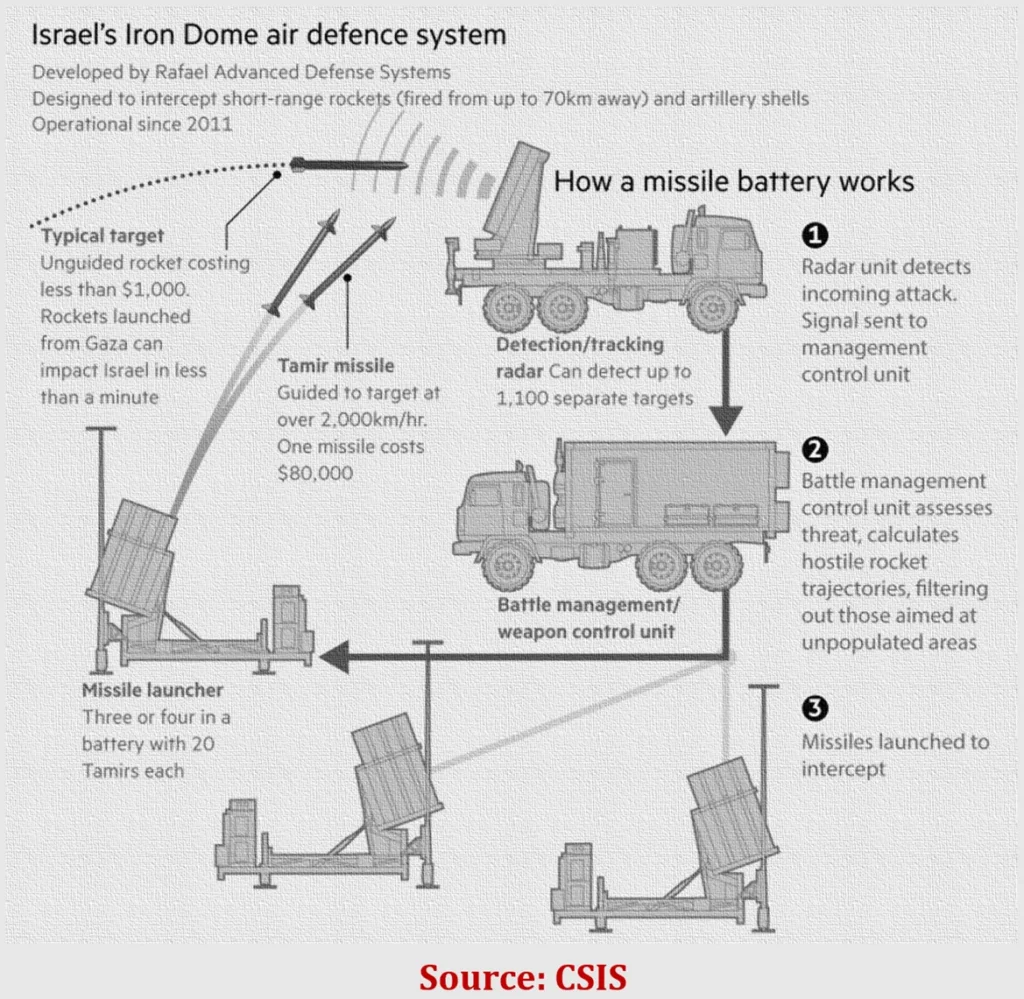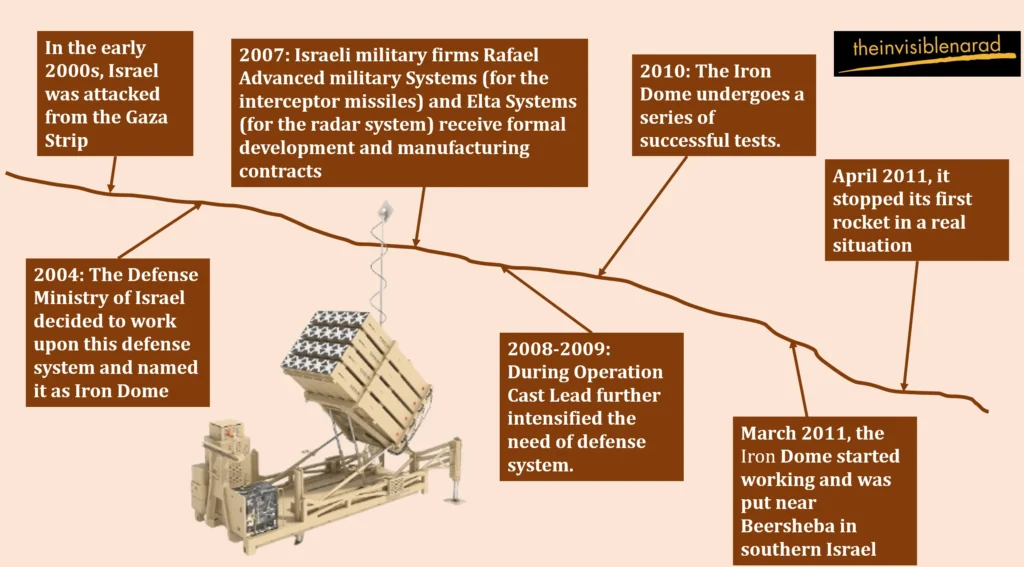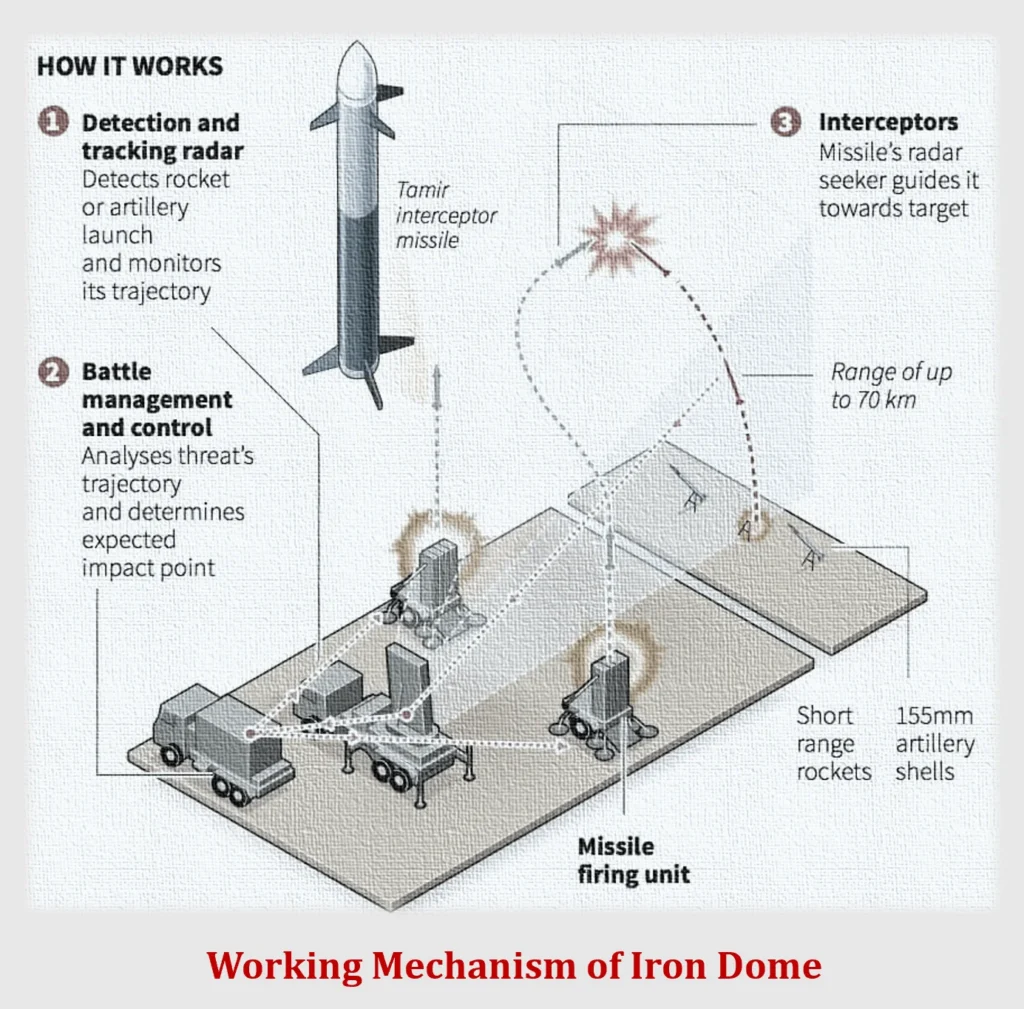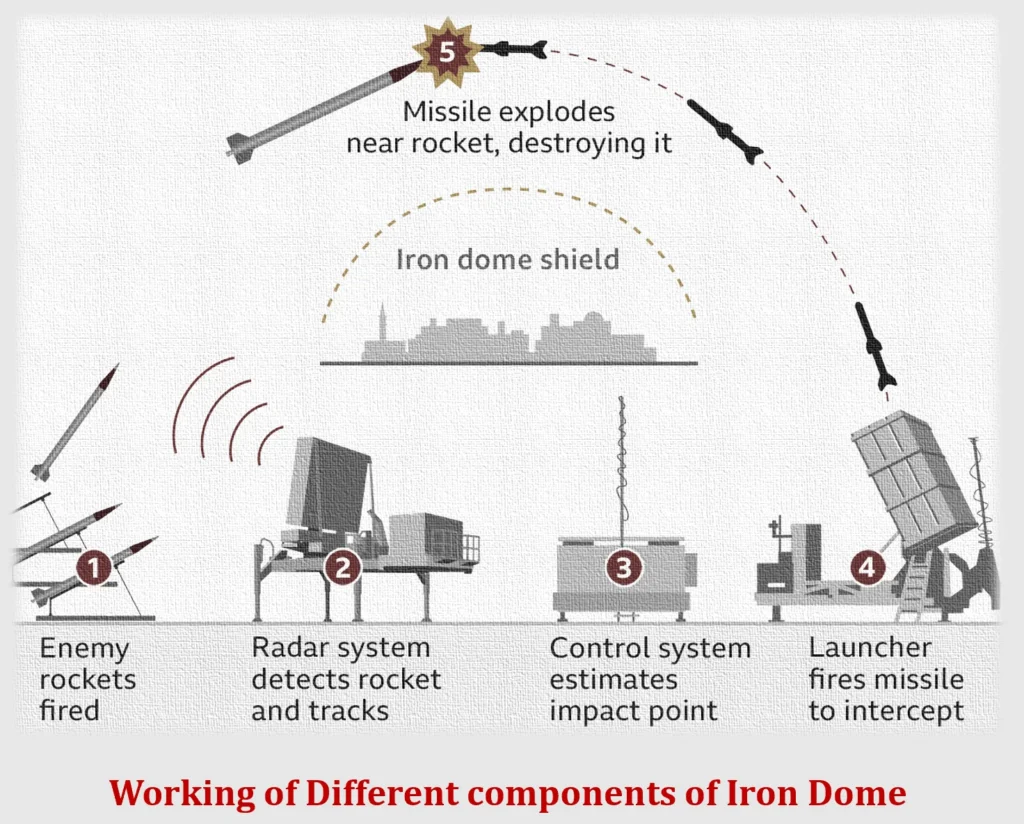
Israel developed and deployed the Iron Dome anti-missile defense system to defend against assaults using short-range rockets and artillery shells. It is made to stop incoming missiles that are headed against populous areas, military sites, or other vital infrastructure and destroy them. So today, I will try to explain the complete Iron dome technology including its advantages and limitations through this bog post.
Historical Background and development of Iron Dome
The development and deployment of Iron Dome technology began in the early 2000s, spurred by the requirement to defend Israel against short-range rocket assaults, notably those launched from the Gaza Strip and southern Lebanon. An overview of significant occasions and turning points in the Iron Dome system’s history is provided below:
- In the early 2000s, Israel faced a problem. Rockets, not very good ones, were being fired from the Gaza Strip and hitting Israeli towns and villages. These assaults were the work of organizations like Islamic Jihad and Hamas. It was obvious that action had to be taken to safeguard people from these rockets.
- Therefore, in 2004, the Defense Ministry of Israel decided to work upon this defense system to counter the above threats. Later it was given the name of the Iron Dome.
- 2007: Israeli military firms Rafael Advanced military Systems (for the interceptor missiles) and Elta Systems (for the radar system) receive formal development and manufacturing contracts.
- 2008-2009: During Operation Cast Lead, a conflict between Israel and Hamas in Gaza, rocket attacks intensify, further highlighting the need for effective missile defense.
- 2010: The Iron Dome undergoes a series of successful tests. The system’s radar and missiles can find, follow, and stop rockets from hitting.
- In March 2011, the Iron Dome started working and was put near Beersheba in southern Israel.
- In April 2011, it stopped its first rocket in a real situation, showing it could really protect people.
- In 2012, during a fight between Israel and Hamas called Operation Pillar of Defense, the Iron Dome stopped lots of rockets. People saw it was a good defense system.
- Operation Protective Edge in 2014, saw the drastic use of Iron Dome to neutralize the rockets launched by Hamas.
- In 2019, the Israel Missile Defense Organization (IMDO) and the U.S. Missile Defense Agency (MDA) said they finished tests for a better version of the Iron Dome. It had better radar and could stop rockets even better.
- In 2020, the United States and Israel agreed to get Iron Dome systems for the U.S. Army. This was the first time the Iron Dome tech went to another country.

The Iron Dome keeps changing and getting better. People are always working on it to make it work even when rockets come and to make it even better at stopping them. It’s super important in Israel to stop short-range rockets and protect people and buildings.
Technical Specifications of Iron Dome
Key features and components of the Iron Dome system include:
- Radar System: The Iron Dome is equipped with advanced radar technology that detects incoming threats as they are launched. The radar tracks the trajectory of these threats and provides crucial data for targeting and interception.
- Battle Management and Control System (BMC): The BMC is responsible for analyzing the incoming threat data, calculating the trajectory, and determining whether an interception is necessary. It makes real-time decisions about which threats to engage.
- Missile Interceptors: To counter approaching challenges, the system fires Tamir interceptor missiles. Assaulting rockets or artillery projectiles are intercepted by these missiles, which then destroy them. Each Tamir missile has its own guidance system and is capable of making modifications while in flight to ensure precise targeting.
- Fire Control Unit: The Fire Control Unit is responsible for launching the Tamir interceptor missiles when necessary. It receives targeting information from the BMC and guides the interceptor to its target.
- Mobility: Iron Dome batteries are mobile and can be transported to different locations as needed. Israel may deploy the device in locations at risk of rocket strikes thanks to its mobility.

The Iron Dome system was put into operation in 2011, has neutralized thousands of rockets and artillery rounds. All these were fired into Israel from Gaza and other adjacent. It has been successful in lessening the harm that these attacks have caused to people. Israel’s multi-layered missile defense system, which also consists of weapons like the Arrow and David’s Sling and is designed to counter threats like cruise missiles and longer-range missiles, includes the Iron Dome as only one component.
Advantages of Iron Dome Technology
The Iron Dome system is really important for protecting Israel from short-range rockets and artillery. It’s super good at stopping and destroying these incoming threats Here are a few of its advantages:
- High Interception Rate: Tests have shown that the Iron Dome system is quite successful at halting and destroying incoming rockets and artillery projectiles. This high interception rate helps protect civilian populations and critical infrastructure from attacks.
- Precision Targeting: Each Tamir interceptor missile is equipped with its own guidance system, allowing for precise targeting of incoming threats. This precision minimizes the risk of collateral damage and ensures that only the intended threat is neutralized.
- Mobility: Iron Dome batteries are mobile and can be quickly deployed to different locations, providing flexibility in defending various areas at risk of rocket attacks. This mobility allows for adaptive defense strategies.
- Short Response Time: The system has a relatively fast response time, which increases the likelihood of intercepting threats before they reach their targets by immediately detecting incoming threats, calculating trajectories, and launching interceptor missiles.
- Lessened Economic Impact: The Iron Dome system helps lessen the economic impact of rocket assaults on Israel by intercepting and eliminating incoming threats. It minimizes damage to infrastructure, reduces the need for extensive post-attack recovery efforts, and helps maintain a sense of normalcy during periods of conflict.
- Psychological Deterrence: The presence of the Iron Dome system serves as a deterrent to potential attackers. A strong likelihood of intercepting incoming rockets and artillery rounds might deter enemies from mounting such attacks in the first place.
- Limited Escalation: Intercepting and neutralizing incoming threats can assist stop disputes from escalating. Without requiring conducting extensive military operations, Israel can respond to rocket assaults, thus lowering the likelihood of escalating the war.
- International Collaboration: As a result of the Iron Dome system’s effectiveness, other nations with a stake in missile defense technology have begun to cooperate and work together. This can enhance diplomatic and strategic partnerships.
However beneficial Iron Dome technology may be, it’s important to remember that every defense system has some drawbacks. In addition, the price of interceptor missiles and system upkeep might be high. Despite this, Israel’s entire defensive plan against rocket and artillery threats still heavily relies on the Iron Dome.
Limitations of Iron Dome Technology
While the Iron Dome technology is highly effective against many short-range rocket and artillery threats, it does have certain limitations, as no defense system is perfect. Some of the limitations of the Iron Dome system include:
- Limited Coverage Area: Iron Dome batteries have a limited coverage area, and they cannot protect an entire country or region. This implies that some locations might still be exposed to rocket assaults, particularly during major wars.
- Range Restrictions: The system is primarily developed to intercept artillery munitions and short-range rockets. In comparison to more sophisticated ballistic missile systems or longer-range missiles that can fly farther and at higher altitudes, it could be less effective.
- Expensive Interceptors: Manufacturing and deploying the Tamir interceptor missiles employed by the Iron Dome system is relatively expensive. Intercepting every incoming threat can be costly, and it may not be economically sustainable in the long term.
- Limited Ammunition: Each Iron Dome battery has a finite supply of interceptor missiles. In prolonged conflicts with a high volume of incoming threats, the system may run out of interceptors, leaving areas vulnerable.
- Countermeasures: The Iron Dome system may be vulnerable to attacks from enemies that devise countermeasures or techniques, such as concurrently releasing volleys of rockets to overwhelm the defense system or employing stealthier, more erratic means of assault.
- Environmental Factors: Adverse weather conditions, like as torrential downpours or ferocious winds, might impact the functioning of the system’s radar and interceptor missiles, thus lowering its efficacy.
- Cost and Maintenance: Maintaining and operating the Iron Dome system requires ongoing investment. The cost of interceptor missiles, as well as routine maintenance and upgrades, can strain defense budgets.
- Diplomatic and Political Considerations: The use of the Iron Dome system can have diplomatic and political implications, as its effectiveness can influence the dynamics of conflicts and negotiations. It may also lead to accusations of disproportionate use of force.
- Limited Defense Against Ground-Based Attacks: Iron Dome is primarily designed to intercept threats coming from the sky. Threats launched from extremely close range to the target or ground-based strikes could not be as effective against it.
Despite these drawbacks, Israel’s protection against threats from short-range artillery and rockets has proven to be effective with the Iron Dome system. It frequently functions as part of a layered defense against various missile threats with other defensive systems like the Arrow and David’s Sling. Additionally, the Israeli defense scientists are working to find solution to these shortcomings.
Working Mechanism of Iron Dome
The Iron Dome is as discussed above aims to intercept and destroy short-range rocket and artillery attacks. The working mechanism of Iron Dome is mentioned below:
- Detection: To identify approaching projectiles, such as rockets or artillery shells, the system employs radar and other sensors. These sensors track the incoming threats and calculate their trajectory and estimated impact point.
- Analysis: The command-and-control center analyzes the sensor data to assess if the oncoming missile is dangerous to inhabited areas. The system moves on to the next stage if it is determined to be a danger.
- Interception: The Iron Dome fires an interceptor missile. These interceptor missiles are equipped with guidance systems and explosive warheads. They are designed to intercept the incoming projectile in the sky.
- Mid-air Intercept: The interceptor missile is guided to the estimated point of intercept, where it uses its onboard sensors to locate and destroy the incoming threat. This is typically done through a direct impact or a proximity explosion.
- Explosion in Mid-air: When the interceptor missile successfully engages the approaching danger, its explosive warhead detonates, obliterating the approaching rocket or artillery round in midair.
- Protection: As a consequence, the population and infrastructure are safeguarded by neutralizing the danger before it can reach its intended target on the ground.

The Iron Dome system is renowned for its capacity to decide in real time whether to intercept a danger or not depending on its trajectory and likelihood of striking populous regions. This capability helps conserve interceptor missiles and make the system more cost-effective.
Conclusion
The Iron Dome system is a great way Israel defends its people from short-range missiles and artillery. It’s one of the best missile defense systems globally, stopping many missiles and saving lots of lives. Even though it showed some weaknesses during a recent surprise attack by Hamas, it’s still a vital part of Israel’s defense plan. It is an effective weapon for defending civilian populations and vital infrastructure because to its high success rate, precise targeting, and mobility. The Iron Dome and other comparable defensive systems must adapt to changing wars and opponents’ new technology and tactics. However, it has some shortcomings that needs to be rectified.
The world, which is under continuous threat of missiles, this type of technology is much need demand to protect the human race. It’s a symbol of innovation and determination. The security and safety of people it guards will be greatly aided by its sustained development and effectiveness.
